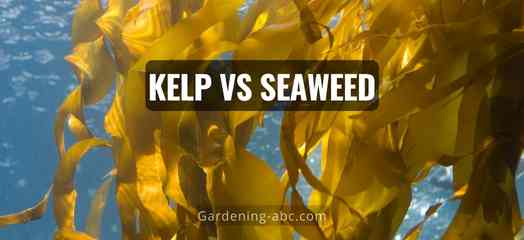We use affiliate links to run our site. When you buy through links on our site, we may earn an affiliate commission, without any added cost to you. Learn more
Although kelp and seaweed are both types of marine algae, there is one fine difference between the two. People often use kelp and seaweeds alternatively and in most cases, there is no difference. But technically they are not the same.
Here in this post, we will share the basic difference between kelp and seaweed and how they are useful to your garden.
What are the main differences between kelp and seaweed?
Seaweed is a type of algae that grows in the ocean. It has a variety of uses, including as food and fertilizer. Kelp is a type of seaweed that grows in the ocean and is used for many purposes, including food and fertilizer.
So when we say seaweeds we not only meant kelp but other algae also whereas when we say kelp we only refer to the kelp type of seaweeds and not others.
Seaweed fertilizer:
Seaweed fertilizer is made from seaweed. It is a natural fertilizer and you can use it to help plants grow. Seaweed fertilizer is prepared by crushing the seaweed and then mixing it with water. Then they are allowed to decompose or ferment in water until the plant material is broken down into a liquid or slurry.
Is Kelp good as a garden fertilizer?

Kelp is a type of seaweed that is found in the ocean. It can be used as a fertilizer for your garden.
Due to Its high nitrogen content kelp has been used as a garden fertilizer for many years. Using kelp is a fantastic way to increase the nitrogen content of the soil. Other than nitrogen kelp also has other nutrients, including potassium, magnesium, and calcium that can help the overall growth of the plants.
If you are growing fruits in your garden it can promote greater fruit and bigger yields.
There are many benefits to using kelp meal fertilizer in your garden. Kelp meal is high in nitrogen, potassium, and other essential nutrients. It can help improve the growth of plants and make them more resistant to disease.
How to use kelp in the garden:
Kelp meal is a high-nutrient fertilizer made from dried and ground-up Kelp. It is a great way to add valuable nutrients to your garden without using synthetic fertilizers.
Kelp meal is a dense powder, so you can add it directly to the soil or mixed with other ingredients before planting.
You can mix it with fish products and use it as a garden fertilizer to encourage healthier plant growth.
Are Seaweed and Kelp the Same Thing
Seaweed and Kelp are not the same. The term seaweed refers to any of a number of different marine algae that grow in salt water. Kelp is a type of seaweed that grows in cold waters, such as the North Pacific Ocean.
Foraging Seaweed for Fertilizer
Seaweed is a form of algae that grows in the ocean. It is used for many purposes, including as fertilizer.
People who live near the ocean often harvest seaweed for food or to make medicine. In some cultures, seaweed is also used to make paper and clothing.
Harvesting seaweed can be a dangerous job because of currents and waves, but it can also be very profitable if done correctly.
what are the different Minerals found in Kelp & Seaweed
Different minerals are found in Kelp and Seaweed. These minerals include Calcium, Iron, Magnesium, Manganese, and Potassium.
The most common mineral found in Kelp is Calcium. It is needed for the development of bones and teeth in humans. Kelp also contains Iron which helps to carry oxygen around the body.
Seaweed contains many minerals like Manganese which helps to maintain healthy skin, Potassium which regulates blood pressure, and Magnesium which helps with muscle function.
Conclusion:
So, there you have it! A closer look at the difference between kelp and seaweed. Be sure to check out our other blog posts for more information on different garden fertilizers.
Amazon and the Amazon logo are trademarks of Amazon.com, Inc, or its affiliates.

Hi there! My name is Prasenjit and I’m an avid gardener and someone who has grown a passion for growing plants. From my hands-on experience, I have learned what works and what doesn’t. Here I share everything I have learned.
